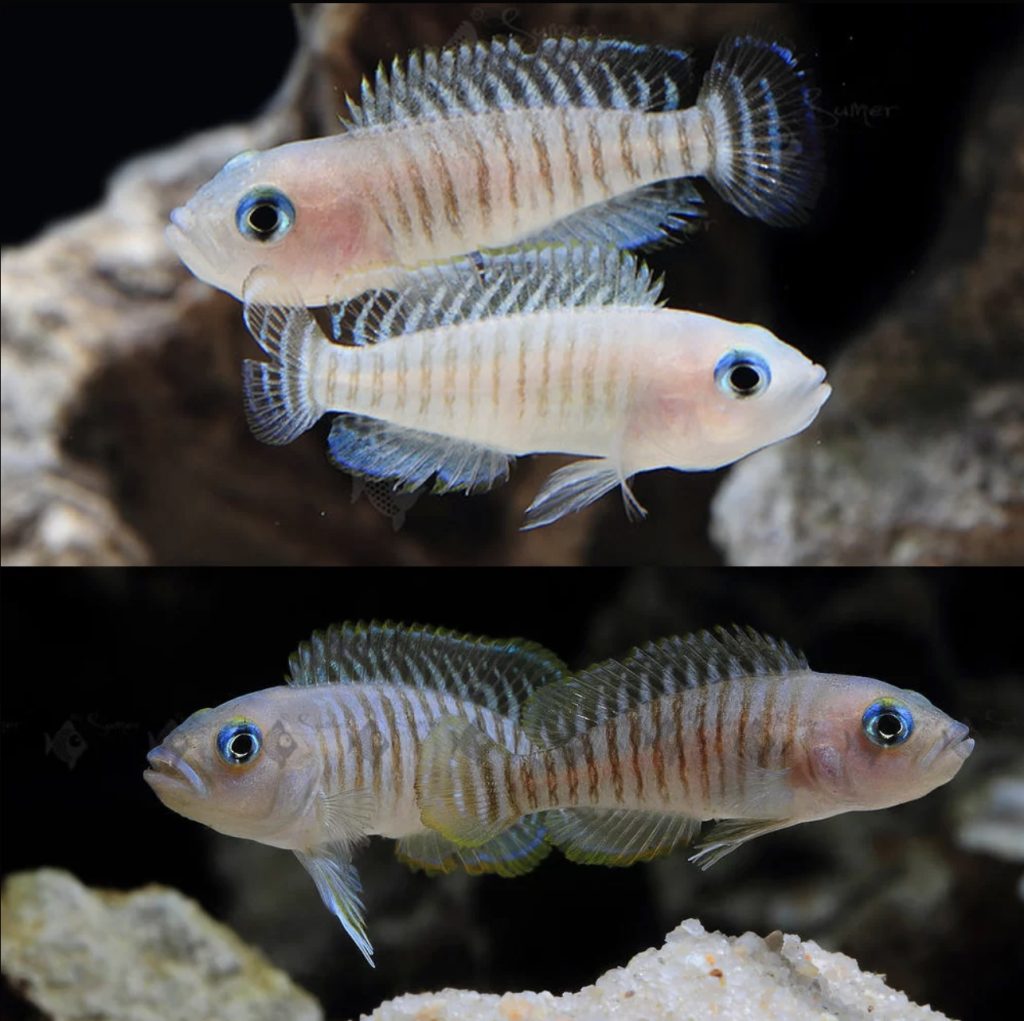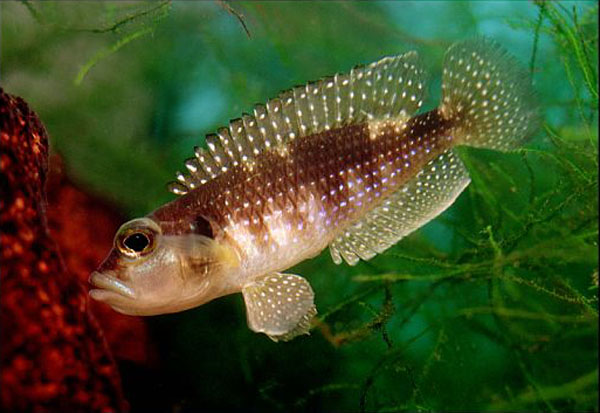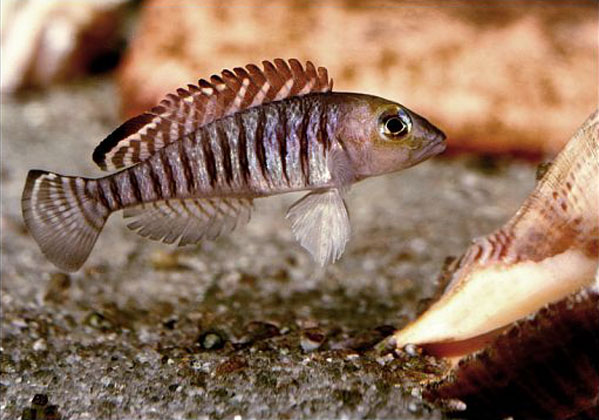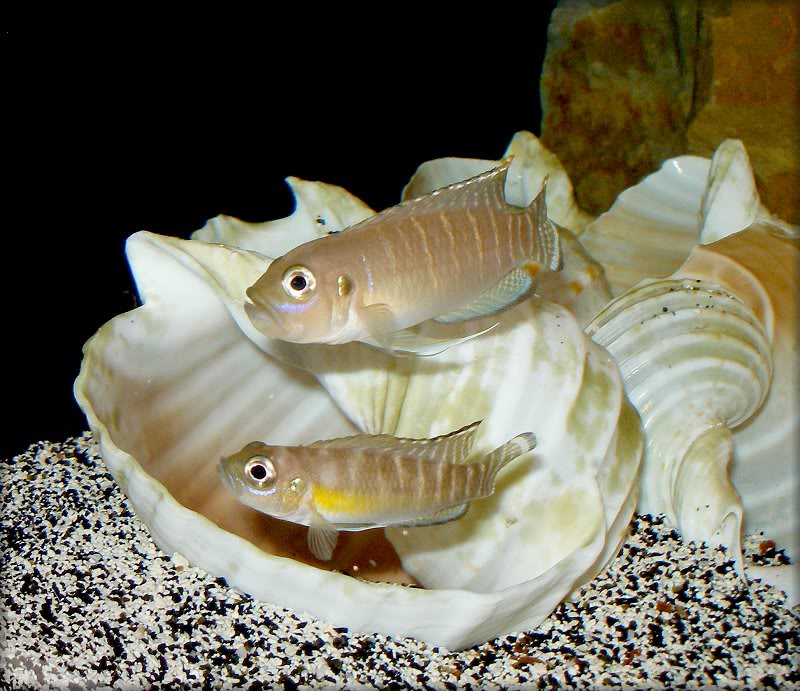In the shimmering depths of Lake Tanganyika, an underwater world of vibrant life and intricate behaviors thrives. Among its many inhabitants, the tiny shell dwellers stand out, not for their brilliant colors, but for their remarkable personalities. These diminutive cichlids might lack the flamboyance of their larger cousins, but their captivating behavior turns any aquarium into a dynamic stage. Watching them navigate their miniature kingdoms is a lesson in nature’s ingenuity.
Years ago, one of my most memorable aquarium setups featured a sprawling community of these fascinating fish. While colorful species filled the mid-water spaces, visitors’ eyes always drifted to the bustling activity at the sandy bottom. The shell dwellers, darting in and out of their chosen homes, had an irresistible charm—a testament to the magic they bring to any tank.

Neolamprologus multifasciatus, the smallest cichlid species, displaying its characteristic bright blue eyes as it guards its shell home. Photo : Florian Graner
A Rich Heritage from Tanganyika
Lake Tanganyika, nestled in Africa’s Great Rift Valley, is a treasure trove of biodiversity. This ancient lake, older than Lake Victoria to the north and Lake Malawi to the south, boasts a stunning array of cichlids. While its species count may not eclipse the other lakes, its variety of forms and behaviors is unparalleled.
Tanganyika is home to the emperor cichlid (Boulengerochromis microlepis), one of the largest cichlids in the world. Yet, its depths also shelter some of the tiniest cichlids, including the remarkable shell dwellers. These fish have carved out a unique ecological niche, making homes in empty snail shells scattered across the lakebed. But where do all these shells come from?
Lake Tanganyika’s ecosystem is a finely balanced web, and predators play a role in providing the abundance of shells. Many cichlid species, adept at extracting snails from their homes, ensure a steady supply of empty shells for the shell dwellers. Male shell dwellers are opportunistic collectors, sometimes resorting to theft—a trait that adds drama to their already intriguing lives.

Lamprologus meleagris, also known as the Pearl Cichlid, showcasing its shimmering spotted pattern as it guards its shell dwelling. Photo: Fredrik Hagblom
Why Shells?
Shells offer these fish more than just shelter; they’re fortresses, nurseries, and battlefields. While Neothauma shells are a favorite due to their perfect size and durability in hard water, shell dwellers will adapt to any suitably sized shell. In aquariums, maintaining water hardness with Tanganyika salts ensures these shells last, replicating their natural environment.
Shell dwellers feed primarily on plankton drifting by, but in the aquarium, they thrive on a diet of dry, frozen, and live foods. Newly hatched brine shrimp are a particular favorite, ensuring their health and vitality. Observing their feeding behavior can be as fascinating as watching their territorial disputes. You might even find yourself rooting for a particularly plucky individual as it darts to snag a morsel before retreating to its shell.
Meet the Shell Dwellers
Let’s dive into the unique characteristics of a few standout species. Each brings a distinctive flair to their tank, making them a joy for aquarists of all levels.
The Striped Shell Dweller (‘Lamprologus’ multifasciatus)
Among the smallest cichlids in the world, L. multifasciatus males rarely exceed 2 inches (5 cm). In Lake Tanganyika, fields of shells serve as sprawling communities for these tiny fish. Males often claim multiple shells, forming harems with several females. However, they’re not shy about evicting a female if her shell contains eggs or fry sired by another male. This behavior mirrors the ruthless territoriality seen in other species, like lions eliminating rivals’ offspring.
In aquariums, L. multifasciatus are social and cooperative. They thrive in colonies, where individuals share the responsibility of protecting young. Despite their diminutive size, they’re endlessly engaging, making them a favorite among visitors—children especially love their quirky antics. Their muted colors belie their lively behavior, proving that personality often outshines appearance.
Suggested Product: Fine-grain sand substrate. Provides the ideal environment for shell dwellers to dig and anchor their homes.

Lamprologus signatus, a striking shell-dwelling cichlid, flaunting its sleek profile near its shell home. Photo: Fredrik Hagblom
The Little Giant (‘L.’ brevis)
Another contender for the title of smallest cichlid, L. brevis males also max out at around 2 inches (5 cm). Unlike their multifasciatus cousins, L. brevis pairs prefer solitude, avoiding colony life. This independence allows them to inhabit regions with fewer shells, carving out a niche in less competitive areas of the lake.
Their monogamous tendencies are fascinating, though males exhibit serial monogamy, moving between females as fry mature. Breeding these fish is straightforward: simply transfer their shell to a rearing tank, ensuring fry safety while minimizing stress on the parents. Their loyalty to their shells highlights the deep instinctual bonds these fish have with their homes.
Suggested Product: Aquarium-safe snail shells or small caves. Perfect for recreating the natural habitats of shell-dwelling cichlids.

Lamprologus brevis couple, a fascinating shell-dweller, resting near their protective shell, showcasing its compact size and subtle coloration. Photo: Sociedad Acuariofila Valenciana
The Eye-Spot Shell Dweller (‘L.’ ocellatus)
For drama, few species rival L. ocellatus. Males, despite their modest size, are fiercely protective. Their bites may not injure, but they’re a bold reminder of their determination. These fish inhabit areas with fine, sandy substrates, so replicating this in aquariums is essential.
Courtship among L. ocellatus is a spectacle. Females, often more colorful than males, use elaborate displays to win access to a male’s shells. Once a pair spawns, the male may court additional females, balancing his attention among them while managing territorial disputes. Watching these interactions is like observing a miniature soap opera, full of intrigue and strategy.
Suggested Product: Fine sand for aquariums. Mimics the natural substrate of Lake Tanganyika’s sandy regions.
Crafting a Shell Dweller Aquarium
A dedicated shell dweller aquarium is a rewarding venture. Their compact size allows aquarists to create thriving colonies in relatively small tanks. For those with larger setups, multiple colonies can coexist, turning the tank into a lively microcosm of Tanganyika’s lakebed.
When setting up their environment:
- Substrate: Use fine sand to allow natural digging behaviors.
- Shells: Provide a variety of sizes to accommodate different species.
- Water Chemistry: Maintain high hardness and alkaline conditions using Tanganyika salts.
- Food: Offer a mix of dry, frozen, and live foods for balanced nutrition.
Beyond these essentials, the joy of observing these fish lies in their interactions. Territorial squabbles, cooperative care, and playful displays bring an aquarium to life. The stories they weave in their tiny world are endlessly compelling.
Suggested product: An approximately 15 gallon fish tanks can be a good start for a shell dweller colony.
A Lifelong Fascination
My journey with shell dwellers began as a curious experiment but quickly became a source of endless fascination. While larger cichlids captivate with their size and colors, these tiny fish hold their own through sheer charm and ingenuity. Watching them transform a tank into a vibrant community reminds us of the wonders hidden in nature’s smallest corners.
Even now, I find myself drawn to their intricate behaviors. Whether it’s the daring theft of a neighbor’s shell or the meticulous care of a clutch of eggs, shell dwellers offer lessons in resilience, adaptability, and the art of making the most of what’s available. For aquarists seeking a window into the complexities of aquatic life, these tiny cichlids are a gateway to endless discovery.
If you’re looking to add a touch of Tanganyika’s magic to your aquarium, shell dwellers are the perfect choice. Their antics will enchant beginners and seasoned aquarists alike, turning every glance into an opportunity to witness something extraordinary.
Related reading:
What is a Cichlid? A Deep Dive into Their Fascinating World
How to Set Up Your Very First Freshwater Aquarium: A Step-by-Step Guide
Discus Demystified: A Practical Guide to Keeping the King of the Aquarium
